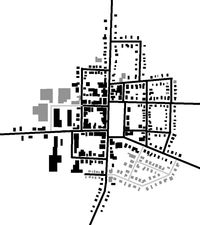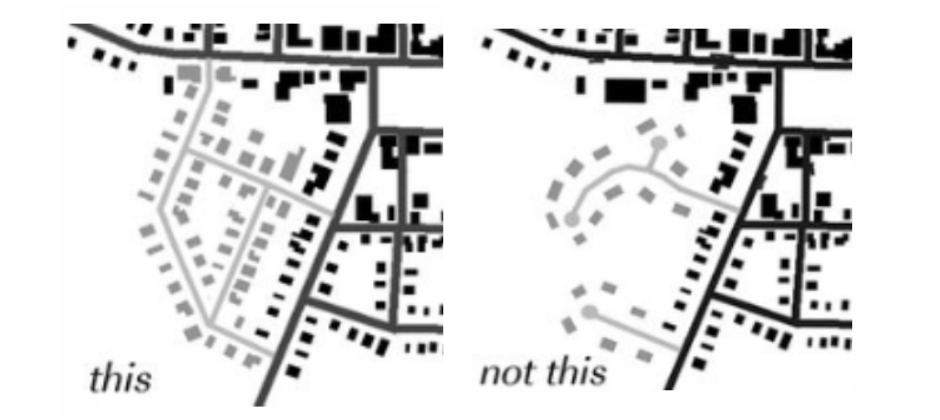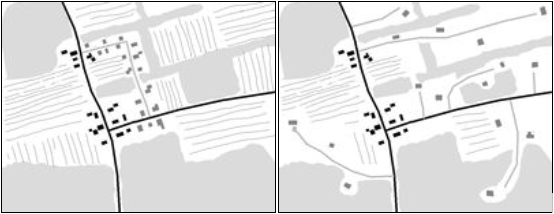Smart growth principles
These ten principles, identified by Smart Growth Vermont, relate to how communities should plan for their future, and reinforce those plans through public policy and community engagement. Integrating these principles into community planning and development requires careful consideration. Key considerations include:
1. Plan development so as to maintain the historic settlement pattern of compact village and urban centers separated by rural countryside.
Sustaining our traditional settlement patterns allows for the efficient use of land, infrastructure, and resources. By targeting new growth into our existing centers, we invest in old neighborhoods first and reduce the fragmentation of our open space. Some ways to accomplish this include:

- Develop clear boundaries outlining areas appropriate for growth and new development;
- Increase allowable densities within area designated for growth;
- Maximize infill potential on vacant land and re-development opportunities on brownfield sites; and
- Ensure that new development is well designed to create an attractive, pedestrian friendly environment that enhances community character.
In this diagram, the light areas represent new commercial, industrial and residential growth that has been incorporated into existing growth patterns.
2. Promote the health and vitality of communities through economic and residential growth that is targeted to compact, mixed use centers, including resort centers, at a scale convenient and accessible for pedestrians and appropriate for the community.
After the second world-war, especially in the 1960’s and 1970’s in Vermont, our communities moved from mixed-use areas to singe-use zones. The result was the isolation of housing from commercial services, civic facilities and schools, and employment centers. Allowing businesses, services and commercial space to mix with housing allows for people to walk to work, stores and services, promotes healthier lifestyles, improves air quality and builds social capital and civic engagement in the community.
Targeting our economic and residential growth to compact, mixed-use centers also promotes economic vitality and lessens our reliance on automobiles, thereby reducing energy consumption and greenhouse gas emissions. And, by using land efficiently, compact development reduces the pressure for development in rural parts of the state.
Spotlight on Vermont’s traditional centers
“We know it when we see it” is a phrase often used when talking about smart growth. But there are elements of our historic villages and towns that distinguish them and make them places where we want to live and work. These include:
- Higher density than surrounding areas
- A mix of uses
- Pedestrian orientation
- Access to public facilities, services and spaces
- A diversity in the type and scale of housing, businesses and industry
- Areas for community engagement and activities
- A contrast with the surrounding countryside, characterized by open spaces, including productive farm and forest land
- A unique cultural heritage
3. Enable choice in the mode of transportation available and ensure that transportation options are integrated and consistent with land use objectives.
In 2003, transportation costs the average American household 19.1% of their annual income – more than the cost of health care, education or food. In addition, many Vermonters can not afford an automobile, making many of the daily chores that most Vermonter’s take for granted a major challenge. Providing transportation options increases accessibility for pedestrians, cyclists and the transportation disadvantaged. This can be accomplished by:

Connected Streets: The above diagrams illustrate two different traffic patterns created by new development (shown in light gray). The diagram on the left highlights several smart growth principles by integrating the new roads with the existing road and providing for a mixture of uses at a density consistent with compact development.
- Connecting existing and new roads instead of creating roads with dead ends;
- Incorporating various types of transportation into your town’s plan;
- Increasing pedestrian and bicycle accessibility by including sidewalks and paths for bikes; and
- Promoting compact settlement patterns that make public transit a viable alternative to the single-occupancy vehicle.
4. Protect and preserve environmental quality and important natural and historic features of Vermont, including natural areas, water resources, air quality, scenic resources, and historic sites and districts.

The diagram above represents protecting buffers. By utilizing smart growth design principles, stream buffers can protect wildlife corridors, preserve water quality and create integrated greenways for the community.
Clean air and water, scenic resources and natural areas are essential to Vermont’s economic future as well as the health and well being of residents and visitors to the state. Some smart growth ways to achieve this goal include: Identifying areas of significant environmental benefit in municipal plans, and protecting those areas through bylaws and other strategies:Incorporating “green infrastructure” into site design;Preserving natural areas through conservation easements and other conservation methods;Creating attractive and pleasant community environments within community centers;Consider the impact of new development of identified scenic resources, such as highway corridors and the mountainous backdrop to many of our distant views, and adopt land use and development standards that ensure that new development is designed to avoid damaging those resources;Inventorying historic sites and structures, and develop bylaw standards that protect those resources and ensure that new development is designed to be compatible with the historic character of the surrounding area.
5. Provide the public with access to formal and informal open spaces, including parks, playgrounds, public greens, water bodies, forests and mountains.
Incorporating formal and informal open spaces into local communities creates a sense of place and provides recreational opportunities, places to meet and natural habitat for various species of wildlife. This is true both within town centers, where public green’s, playgrounds, recreation fields and pathways serve as important community gathering places, as well as in rural settings where maintaining access to undeveloped land for such traditional activities as hiking and skiing, hunting and fishing, paddling and snow-mobiling is a growing challenge.
6. Encourage and strengthen agricultural and forest enterprises and minimize conflicts of development with these businesses.
Maintaining and enhancing land used for agriculture and forestry is an important characteristic of smart growth. By identifying these areas, a community can sustain productive farm and forest land, and other natural resources, and take steps to maintain contiguous tracts of open land and minimize the types of conflicts that can emerge when the residents of that new housing development may be unfamiliar with the sites, sounds and smells of agriculture and forest management.

The diagram above represents subdivision design: conserving farmland while building homes. Subdivision designs can achieve the same density of units without consuming productive farm land and open space. This can allow agricultural land to stay in production, increase infrastructure efficiency, and can lead to the creation of open spaces for community use. Note: Both images have the same density, the only difference is in the size of the lots.
7. Provide for housing that meets the needs of a diversity of social and income groups in each Vermont community, but especially in communities that are most rapidly growing.
Within most communities, there is a need for homes for those just out of college, young couples, families, empty nesters and seniors. Until recently, land for residential development in many rural locations was affordable to a broad cross section of Vermonters. That is no longer the case, as housing developments in suburban “sprawl” locations typically meet the needs of a single socio-economic demographic, and Vermont residents are competing with affluent out-of state buyers for the rural home-site.
Smart growth encourages communities to plan for a variety of housing types, including apartments, condominiums, and town homes, in addition to single family homes. It allows for appropriate densities and housing diversity that meets the needs of a full range of Vermonters from diverse social and income groups.
8. Support a diversity of viable business enterprises in downtowns and villages, including locally-owned businesses, and a diversity of agricultural and forestry enterprises in the countryside.
Fostering business growth and development in downtowns and villages reinforces those areas as a center of community life and contributes to social integration of all community members. It is also an effective use of existing infrastructure and a way to maximize past public investment in established centers. Balancing economic development in downtown businesses with opportunities for agricultural and forestry enterprises in the countryside also maintains the state’s historic landscape, and prevents scattered commercial development along highways strips from undermining the vitality of downtowns and villages.
9. Balance growth with the availability of economic and efficient public utilities and services and through the investment of public funds consistent with these principles.
It is an understatement to say that Vermont has scarce public resources, and that we should make a commitment to invest public funds in the most efficient and cost effective manner possible. Further, public spending decisions should be coordinated with land use and development decisions to ensure that we are fostering smart growth by targeting areas for public utilities and services, and avoiding the extension of those utilities into areas that are identified in local plans for conservation.
10. Accomplish goals and strategies for smart growth through coalitions with stakeholders and engagement of the public.
To gain public confidence and credibility for the planning and implementation process, engaging the public is a key component of success. Greater understanding of the goals, policies and strategies help alleviate fears and create a community dialogue that can build understanding of divergent points of view.



